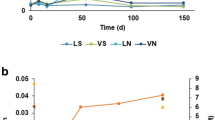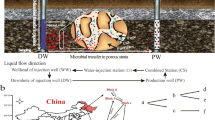Abstract
The microbial response to produced water reinjection (PWRI) in a North Sea oil field was investigated by a combination of cultivation and culture-independent molecular phylogenetic techniques. Special emphasise was put on the relationship between sulphate-reducing bacteria (SRB) and nitrate-reducing bacteria (NRB), and results were used to evaluate the possibility of nitrate treatment as a souring management tool during PWRI. Samples were collected by reversing the flow of the injection water, which provided samples from around the injection area. The backflowed samples were compared to produced water from the same platform and to backflowed samples from a biocide-treated seawater injector, which was the previous injection water treatment of the PWRI well. Results showed that reinjection of produced water promoted growth of thermophilic SRB. Thermophilic fatty acid oxidising NRB and potential nitrate-reducing sulphide-oxidising bacteria were also found. The finding of thermophilic NRB makes nitrate treatment during PWRI possible, although higher nitrate concentration will be necessary to compensate for the increased SRB activity.







Similar content being viewed by others
References
Altschul SF, Madden TL, Schaffer AA, Zhang JH, Zhang Z, Miller W, Lipman DJ (1997) Gapped BLAST and PSI-BLAST: a new generation of protein database search programs. Nucleic Acids Res 25:3389–3402
Baker GC, Cowan DA (2004) 16S rDNA primers and the unbiased assessment of thermophile diversity. Biochem Soc Trans 32:218–221
Beeder J, Nilsen RK, Rosnes JT, Torsvik T, Lien T (1994) Archaeoglobus fulgidus isolated from hot North Sea oil field waters. Appl Environ Microbiol 60:1227–1231
Beeder J, Torsvik T, Lien TL (1995) Thermodesulforhabdus norvegicus gen. nov., sp. nov., a novel thermophilic sulfate-reducing bacterium from oil field water. Arch Microbiol 164:331–336
Bjørnestad EØ, Sunde E, Dinning A (2005) The effect of produced water reinjection on reservoir souring in the Statfjord field. Petroleum Abstracts, vol 884455, Geilo, Norway
Bødtker G, Lysnes K, Torsvik T, Bjørnestad EØ, Sunde E (2009) Microbial analysis of backflowed injection water from a nitrate-treated North Sea oil reservoir. J Ind Microbiol Biotechnol 36:439–450
Christensen B, Torsvik T, Lien T (1992) Immunomagnetically captured thermophilic sulfate-reducing bacteria from North Sea oil field waters. Appl Environ Microbiol 58:1244–1248
Cordruwisch R (1985) A quick method for the determination of dissolved and precipitated sulfides in cultures of sulfate-reducing bacteria. J Microbiol Methods 4:33–36
Delong EF (1992) Archaea in Coastal Marine Environments. Proc Natl Acad Sci U S A 89:5685–5689
Felsenstein J (1989) PHYLIP—phylogeny inference package (version 3.2). Cladistics 5:164–166
Fjellbirkeland A, Torsvik V, Øvreås L (2001) Methanotrophic diversity in an agricultural soil as evaluated by denaturing gradient gel electrophoresis profiles of pmoA, mxaF and 16S rDNA sequences. Antonie Van Leeuwenhoek 79:209–217
Gevertz D, Telang AJ, Voordouw G, Jenneman GE (2000) Isolation and characterization of strains CVO and FWKOB, two novel nitrate-reducing, sulfide-oxidizing bacteria isolated from oil field brine. Appl Environ Microbiol 66:2491–2501
Grabowski A, Nercessian O, Fayolle F, Blanchet D, Jeanthon C (2005) Microbial diversity in production waters of a low-temperature biodegraded oil reservoir. FEMS Microbiol Ecol 54:427–443
Grassia GS, McLean KM, Glenat P, Bauld J, Sheehy AJ (1996) A systematic survey for thermophilic fermentative bacteria and archaea in high temperature petroleum reservoirs. FEMS Microbiol Ecol 21:47–58
Greene AC, Patel BKC, Sheehy AJ (1997) Deferribacter thermophilus gen. nov., sp. nov., a novel thermophilic manganese- and iron-reducing bacterium isolated from a petroleum reservoir. Int J Syst Bacteriol 47:505–509
Hubert C, Nemati M, Jenneman G, Voordouw G (2005) Corrosion risk associated with microbial souring control using nitrate or nitrite. Appl Microbiol Biotechnol 68:272–282
Jackson CR, Langner HW, Donahoe-Christiansen J, Inskeep WP, McDermott TR (2001) Molecular analysis of microbial community structure in an arsenite-oxidizing acidic thermal spring. Environ Microbiol 3:532–542
Lien T, Madsen M, Rainey FA, Birkeland NK (1998) Petrotoga mobilis sp. nov., from a North Sea oil-production well. Int J Syst Bacteriol 48:1007–1013
Lysnes K, Thorseth IH, Steinsbu BO, Ovreas L, Torsvik T, Pedersen RB (2004) Microbial community diversity in seafloor basalt from the Arctic spreading ridges. FEMS Microbiol Ecol 50:213–230
Magot M, Caumette P, Desperrier JM, Matheron R, Dauga C, Grimont F, Carreau L (1992) Desulfovibrio longus sp.nov., a sulfate-reducing bacterium isolated from an oil-producing well. Int J Syst Bacteriol 42:398–403
Muyzer G, Dewaal EC, Uitterlinden AG (1993) Profiling of complex microbial populations by denaturing gradient gel electrophoresis analysis of polymerase chain reaction-amplified genes coding for 16s ribosomal-RNA. Appl Environ Microbiol 59:695–700
Myhr S, Torsvik T (2000) Denitrovibrio acetiphilus, a novel genus and species of dissimilatory nitrate-reducing bacterium isolated from an oil reservoir model column. Int J Syst Evol Microbiol 50:1611–1619
Myhr S, Lillebø BLP, Sunde E, Beeder J, Torsvik T (2002) Inhibition of microbial H2S production in an oil reservoir model column by nitrate injection. Appl Microbiol Biotechnol 58:400–408
Nilsen RK, Torsvik T (1996) Methanococcus thermolithotrophicus isolated from North Sea oil field reservoir water. Appl Environ Microbiol 62:728–731
Orphan VJ, Taylor LT, Hafenbradl D, Delong EF (2000) Culture-dependent and culture-independent characterization of microbial assemblages associated with high-temperature petroleum reservoirs. Appl Environ Microbiol 66:700–711
Øvreås L, Forney L, Daae FL, Torsvik V (1997) Distribution of bacterioplankton in meromictic Lake Saelenvannet, as determined by denaturing gradient gel electrophoresis of PCR-amplified gene fragments coding for 16S rRNA. Appl Environ Microbiol 63:3367–3373
Ravot G, Magot M, Fardeau ML, Patel BKC, Prensier G, Egan A, Garcia JL, Ollivier B (1995a) Thermotoga elfii sp. nov., a novel thermophilic bacterium from an African oil-producing well. Int J Syst Bacteriol 45:308–314
Ravot G, Ollivier B, Magot M, Patel BKC, Crolet JL, Fardeau ML, Garcia JL (1995b) Thiosulfate reduction, an important physiological feature shared by members of the order Thermotogales. Appl Environ Microbiol 61:2053–2055
Rees GN, Patel BKC, Grassia GS, Sheehy AJ (1997) Anaerobaculum thermoterrenum gen. nov., sp. nov., a novel, thermophilic bacterium which ferments citrate. Int J Syst Bacteriol 47:150–154
Reinsel MA, Sears JT, Stewart PS, McInerney MJ (1996) Control of microbial souring by nitrate, nitrite or glutaraldehyde injection in a sandstone column. J Ind Microbiol 17:128–136
Sunde E, Thorstenson T, Torsvik T, Vaag JE, Espedal MS (1993) Field-related mathematical model to predict and reduce reservoir souring. Soc Petrol Eng SPE 25197:449–456
Sunde E, Lillebø BLP, Bødtker G, Torsvik T, Thorstenson T (2004) H2S inhibition by nitrate injection on the Gullfaks field. Corrosion 2004 Paper 04760. NACE International, Houston
ter Braak CJF (1986) Canonical correspondence analysis: a new eigenvector technique for multivariate direct gradient analysis. Ecology 67:1167–1179
ter Braak CJF, Smilauer P (1998) CANOCO reference manual and users guide to Canoco for Windows. Software for canonical community ordination (version 4). Centre for Biometry and Microcomputer Power, Wageningen and Ithaca
Thompson JD, Higgins DG, Gibson TJ (1994) CLUSTAL-W—improving the sensitivity of progressive multiple sequence alignment through sequence weighting, position-specific gap penalties and weight matrix choice. Nucleic Acids Res 22:4673–4680
Treusch AHS, Leininger S, Kletzin A, Schuster SC, Klenk HP, Schleper C (2005) Novel genes for nitrite reductase and Amo-related proteins indicate a role of uncultivated mesophilic crenarchaeota in nitrogen cycling. Environ Microbiol 7:1985–1995
Vance I, Thrasher DR (2005) Reservoir souring: mechanisms and prevention. In: Ollivier B, Magot M (eds) Petroleum microbiology. ASM Press, Washington, DC, pp 123–142
Voordouw G, Armstrong SM, Reimer MF, Fouts B, Telang AJ, Shen Y, Gevertz D (1996) Characterization of 16S rRNA genes from oil field microbial communities indicates the presence of a variety of sulfate-reducing, fermentative, and sulfide-oxidizing bacteria. Appl Environ Microbiol 62:1623–1629
Whitman WB, Bowen TL, Boone DR (2006) The methanogenic bacteria. In: Dworkin M, Falkow S, Rosenberg E, Schleifer KH, Stackebrandt E (eds) The Procaryotes, vol 3. Springer, New York, pp 165–207
Widdel F, Pfennig N (1981) Studies on dissimilatory sulfate-reducing bacteria that decompose fatty acids. I. Isolation of new sulfate-reducing bacteria enriched with acetate from saline environments—description of Desulfobacter postgatei gen. nov., sp. nov. Arch Microbiol 129:395–400
Yoshida N, Yagi K, Sato D, Watanabe N, Kuroishi T, Nishimoto K, Yanagida A, Katsuragi T, Kanagawa T, Kurane R, Tani Y (2005) Bacterial communities in petroleum oil in stockpiles. J Biosci Bioeng 99:143–149
Acknowledgments
This work was supported by Statoil and the Norwegian Research Council through the Petromaks programme. The authors wish to thank Bente Edel Thorbjørnsen, Nirmaladevi Sivasambu, Rikke Helen Ulvøen, Bente-Lise Polden Lillebø, and Tove Leiknes at Unifob Petroleum, Section for Microbiology, University of Bergen, for technical assistance.
Author information
Authors and Affiliations
Corresponding author
Rights and permissions
About this article
Cite this article
Lysnes, K., Bødtker, G., Torsvik, T. et al. Microbial response to reinjection of produced water in an oil reservoir. Appl Microbiol Biotechnol 83, 1143–1157 (2009). https://doi.org/10.1007/s00253-009-2015-7
Received:
Revised:
Accepted:
Published:
Issue Date:
DOI: https://doi.org/10.1007/s00253-009-2015-7




